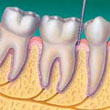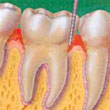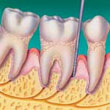Gum Disease Screening
Periodontal disease (also known as gum disease) is a condition that causes more adult to lose their teeth than any other dental related condition. It is an infection that affects the tissues and bone that support teeth. Healthy gums tissue fits like a cuff around each tooth. When someone has periodontal disease, the gum tissue pulls away from the tooth. As the disease worsens, the tissue and bone that support the tooth are destroyed. Over time, teeth may fall out or need to be removed.
What are the stages of Gum Disease?
- Gingivitis is the mildest form of periodontal disease. It causes the gums to become red, swollen, and bleed easily. There is usually little or no discomfort at this stage. Gingivitis is often caused by inadequate oral hygiene. Gingivitis is reversible with professional treatment and good oral home care.
- Periodontitis: at this stage, the supporting bone and fibers that hold your teeth in place are irreversibly damaged. Your gums may begin to form a pocket below the gum line, which traps food and plaque. Proper dental treatment and improved home care can usually help prevent further damage.
- Advanced Periodontitis: in this final stage of gum disease, the fibers and bone supporting your teeth are destroyed, which can cause your teeth to shift or loosen. This can affect your bite and, if aggressive treatment can’t save them, teeth may need to be removed.
Periodontitis
How is Gum Disease Treated?
Periodontal disease and whole-body heath
Did you know that active infection inside of your mouth can also make it difficult to recover from other types of health conditions? This is due to the bacteria entering through the infected gums where bleeding is occurring, allowing it to travel throughout your body. Not only can it lodge in areas like your heart or blood vessels, it also places a strain on your immune system.
Many people who have active gum disease find themselves with an increased risk of:
- Unmanaged diabetes
- Obesity
- Erectile dysfunction
- Cardiovascular diseases (including stroke and heart attack)
- Premature labor and low birth weight infants

Healthy Gums – healthy gums are firm and don’t bleed. They fit snugly around the teeth.

Gingivitis – gums are mildly inflamed, may appear red or swollen and may bleed during brushing.

Periodontitis – gums begin to separate and recede from the teeth. This allows plaque to move toward the roots, supporting fibers and bone.

Advanced Periodontitis – supporting fibers and bone are destroyed. Teeth become loose and may need to be removed.
